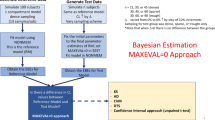Abstract
Non-compartmental analysis (NCA) is regarded as the standard for establishing bioequivalence, despite its limitations and the existence of alternative methods such as non-linear mixed effects modelling (NLMEM). Comparisons of NCA and NLMEM in bioequivalence testing have been limited to drugs with one-compartment kinetics and have included a large number of different approaches. A simulation tool was developed with the ability to rapidly compare NCA and NLMEM methods in determining bioequivalence using both R and NONMEM and applied to a drug with two-compartment pharmacokinetics. Concentration–time profiles were simulated where relative bioavailability, random unexplained variability (RUV) at the lower limit of quantification (LLOQ) differed between simulations. NLMEM analyses employed either the M1 or M3 methods for dealing with values below the LLOQ. It was used to elucidate the impact of changes in (i) RUV at the LLOQ, (ii) the extent of censoring data below the LLOQ and (iii) the concentration sampling times. The simulations showed NLMEM having a consistent 20–40% higher accuracy and sensitivity in identifying bioequivalent studies when compared to NCA, while NCA was found to have a 1–10% higher specificity than NLMEM. Increasing data censoring by increasing the LLOQ resulted in decreases of ~10% to the accuracy and sensitivity of NCA, with minimal effects on NLMEM. The tool provides a platform for comparing NCA and NLMEM methods and its use can be extended beyond the scenarios reported here. In the situations examined it is seen that NLMEM is more accurate than NCA and may offer some advantages in the determination of bioequivalence.




Similar content being viewed by others
References
EMA (2010) Guideline on the investigation of bioequivalence. European Medicines Agency, London
Gabrielsson J, Weiner D (2010) Pharmacokinetic and pharmacodynamic data analysis: concepts and applications, vol 929, 4th edn. Swedish Pharmaceutical Press, Sweden. doi:10.1002/psp4.12087
FDA (2001) Guidance for industry statistical approaches to establishing bioequivalence. Food and Drug Administration, USA
FDA (2001) Guidance for industry bioanalytical method validation. Food and Drug Administration, USA
Bulitta JB, Holford NHG (2007) Non-compartmental analysis. Wiley encyclopedia of clinical trials. Wiley, Hoboken. doi:10.1002/9780471462422.eoct340
Wu JC, Nafziger AN, Bertino JS Jr, Ma JD (2012) Limitations of S-warfarin truncated area under the concentration-time curve to predict cytochrome P450 2c9 activity. Drug Metab Lett 6(2):94–101. doi:10.2174/1872312811206020094
Sheiner L, Wakefield J (1999) Population modelling in drug development. Stat Methods Med Res 8(3):183–193. doi:10.1177/096228029900800302
Mould DR, Upton RN (2012) Basic concepts in population modeling, simulation, and model-based drug development. CPT Pharmacomet Syst Pharmacol. doi:10.1038/psp.2012.4
Mould DR, Upton RN (2013) Basic concepts in population modeling, simulation, and model-based drug development-Part 2: introduction to pharmacokinetic modeling methods. CPT Pharmacomet Syst Pharmacol. doi:10.1038/psp.2013.14
Dubois A, Gsteiger S, Pigeolet E, Mentre F (2010) Bioequivalence tests based on individual estimates using non-compartmental or model-based analyses: evaluation of estimates of sample means and type I error for different designs. Pharm Res 27(1):92–104. doi:10.1007/s11095-009-9980-5
Beal SL (2001) Ways to fit a PK model with some data below the quantification limit. J Pharmacokinet Pharmacodyn 28(5):481–504. doi:10.1023/A:1012299115260
Panhard X, Mentré F (2005) Evaluation by simulation of tests based on non-linear mixed-effects models in pharmacokinetic interaction and bioequivalence cross-over trials. Stat Med 24(10):1509–1524. doi:10.1002/sim.2047
Combrink M, McFadyen ML, Miller R (1997) A comparison of the standard approach and the NONMEM approach in the estimation of bioavailability in man. J Pharm Pharmacol 49(7):731–733. doi:10.1111/j.2042-7158.1997.tb06101.x
Keizer RJ, Zamacona MK, Jansen M, Critchley D, Wanders J, Beijnen JH, Schellens JH, Huitema AD (2009) Application of population pharmacokinetic modeling in early clinical development of the anticancer agent E7820. Investig New Drugs 27(2):140–152. doi:10.1007/s10637-008-9164-x
Pentikis HS, Henderson JD, Tran NL, Ludden TM (1996) Bioequivalence: individual and population compartmental modeling compared to the noncompartmental approach. Pharm Res 13(7):1116–1121. doi:10.1023/A:1016083429903
Core Team R (2013) R: a language and environment for statistical computing. R Foundation for Statistical Computing, Vienna
Beal S, Sheiner LB, Boeckmann A, Bauer RJ (2009) NONMEM user’s guides (1989–2009). Icon Development Solutions, Ellicott City
Pharsight Corporation (2003) WinNonlin User’s Guide. WinNonlin 4.1
Byon W, Fletcher CV, Brundage RC (2008) Impact of censoring data below an arbitary quantification limit on structural model misspecification. J Pharmacokinet Pharmacodyn 35(1):101–116. doi:10.1007/s10928-007-9078-9
Yin P, Fan X (2001) Estimating R 2 shrinkage in multiple regression: a comparison of different analytical methods. J Exp Educ 69(2):203–224. doi:10.1080/00220970109600656
Hamidi M (2010) Pharmacokinetic properties of indinavir in rat: some limitations of noncompartmental analysis. Drug Dev Ind Pharm 36(3):355–361. doi:10.1080/03639040903173564
Acknowledgements
The authors acknowledge that the Australian Centre for Pharmacometrics is an initiative of the Australian Government as part of the National Collaborative Research Infrastructure Strategy.
Author information
Authors and Affiliations
Corresponding author
Ethics declarations
Conflicts of interest
The authors declare that they have no conflict of interest.
Electronic supplementary material
Below is the link to the electronic supplementary material.
Rights and permissions
About this article
Cite this article
Hughes, J.H., Upton, R.N. & Foster, D.J.R. Comparison of non-compartmental and mixed effect modelling methods for establishing bioequivalence for the case of two compartment kinetics and censored concentrations. J Pharmacokinet Pharmacodyn 44, 233–244 (2017). https://doi.org/10.1007/s10928-017-9511-7
Received:
Accepted:
Published:
Issue Date:
DOI: https://doi.org/10.1007/s10928-017-9511-7




